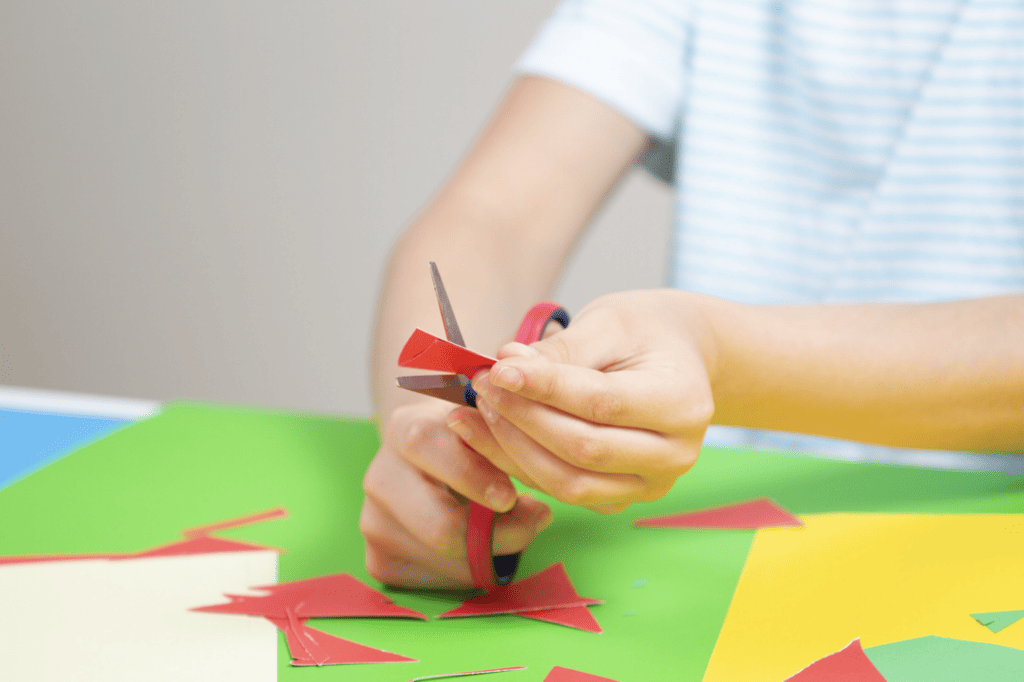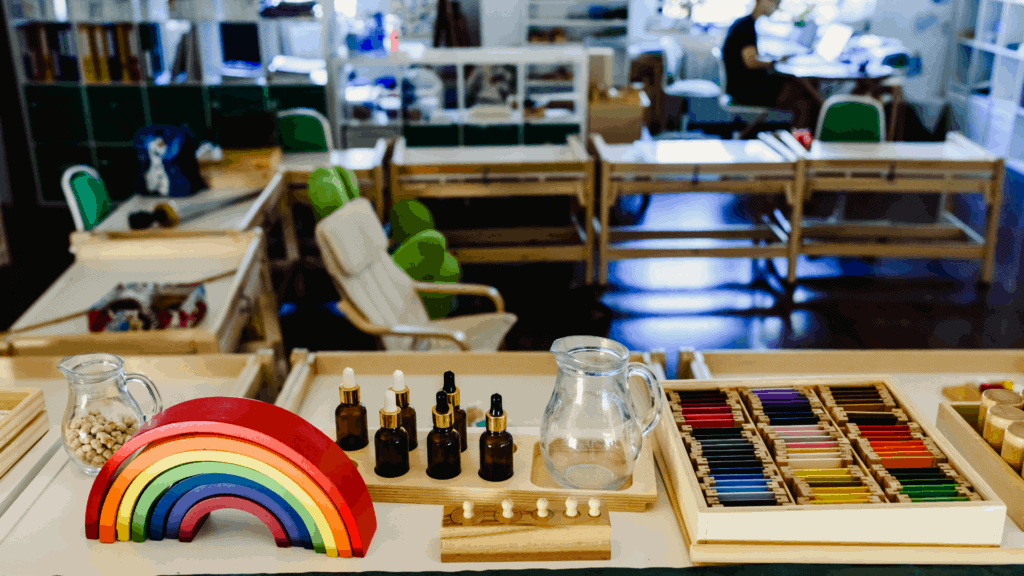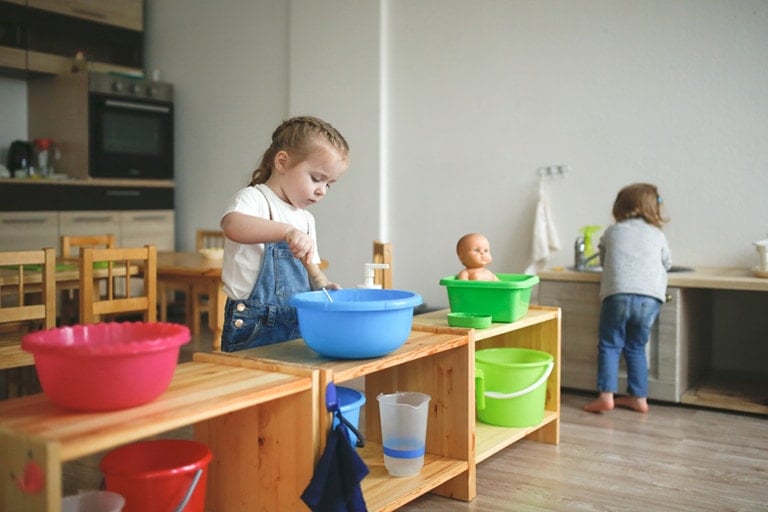Preschool-aged children, typically between the ages of 4-5, are in a crucial stage of development where they are eager to explore and learn about the world around them. These
Here are 12 Great Montessori Activities for 4 to 5 year olds.
On This Page…
- Here are 12 Great Montessori Activities for 4 to 5 year olds.
- 1. Cutting Activities
- 2. Bird Watching
- 3. Coin Sorting
- 4. Weaving
- 5. Grinding Herbs in a Pestle and Mortar
- 6. Leaf Polishing
- 7. Scrubbing
- 8. Sewing and Stitching
- 9. Setting the Table
- 10. Peeling and Cutting Fruits and Vegetables
- 11. Matching Sounds
- 12. Nature Walk and Name
1. Cutting Activities
Cutting activities are great Practical Life activities to help strengthen 4-5 year old’s fine motor skills.
To set up a cutting activity, you will need:
- Child-sized scissors
- A tray or mat to contain the activity
- Various materials to cut, such as paper, or straws.
You can also include a bowl or basket to collect the cuttings. You can provide a piece of paper and glue for the child to glue their cuttings. Another cutting activity is to print (or draw) shapes for the preschooler to cut out.
Why It’s Beneficial: Cutting activities help children to develop hand-eye coordination while working on their fine motor skills. Additionally, cutting activities aid in the development of concentration.

2. Bird Watching
Bird watching is an activity that aligns with the
For this activity, all you need is a bird book and child-sized binoculars. You can, however, do the exercise with home-printed pictures of common birds only. If you are setting up a bird-watching station for your child indoors, provide them with a comfy chair with a good window view.
If at all possible provide a bird feeder (a great DIY project to involve preschoolers in), with some seed to attract the birds.
Why It’s Beneficial: This activity helps children develop their observation skills and increases their awareness of the natural world around them.
3. Coin Sorting
The
To set up a sorting coins activity, you will need:
- A tray or mat to contain the activity
- A set of coins of different denominations (such as pennies, nickels, dimes, and quarters)
- A sorting dish or container for each type of coin.
Why It’s Beneficial: It helps children develop their sorting and categorizing skills and understand different types of coins and their values. Additionally, this activity allows children to practice counting and basic arithmetic skills while strengthening fine motor skills.
4. Weaving
Montessori weaving activities correspond to the Practical Life curriculum and are surprisingly simple to set up using items at home.
For this activity, you will need:
- A lined frame that can be used to weave ribbon through
- Ribbon or yarn. You can adjust the material used to weave based on the child’s developmental needs.
Why It’s Beneficial: Weaving is a practical life activity that helps children develop fine motor skills, hand-eye coordination, and concentration. This activity also enhances their understanding of textures and patterns.
5. Grinding Herbs in a Pestle and Mortar
Grinding herbs in a pestle and mortar is a
To set up the activity you will need:
- A mortar and pestle
- A variety of dried or fresh herbs
- A small container or tray to contain the activity.
The activity begins with the child selecting the herbs they want to grind, and placing them into the mortar. The child then uses the pestle to grind the herbs, going back and forth until they are finely ground. The child can also be encouraged to use their sense of smell to identify the different herbs and their fragrances.
Why It’s Beneficial: This activity helps to develop the child’s sensory awareness, as they can smell and feel the different herbs. Secondly, it encourages hand-eye coordination and fine motor skills, as the child manipulates the pestle and mortar.
6. Leaf Polishing
Leaf polishing falls under the Practical Life area of Care of the environment. Leaf polishing or leaf washing helps children to connect with nature while learning how to take care of their environment.
For this activity, you will need:
- A potted plant
- A bowl of water
- A sponge.
First, demonstrate to the child how to wipe the dust from the plant’s leaves and then ask the child to clean the leaves.
Why It’s Beneficial: The
7. Scrubbing
Scrubbing is a Practical Life activity that is versatile and done with items around the house. You can set up scrubbing activities that focus on fine motor skill development or gross motor skills.
To set up a scrubbing activity, you will need:
- A small tray or container
- A variety of items that can be scrubbed (such as small plastic toys or utensils)
- A bowl of warm soapy water, and a soft brush or sponge.
Alternatively, provide water, a brush, and a child-sized table to be scrubbed.
Why It’s Beneficial: Scrubbing helps to develop the child’s practical life skills, as they learn how to clean and care for different items. It also encourages sensory awareness and hand-eye coordination.
It promotes independence and confidence, as the child learns to complete a task from start to finish on their own.
8. Sewing and Stitching
Sewing and stitching are Practical Life activities that will spark interest in 4-5-year-olds. For this activity, some materials are required.
For this activity, you will need:
- An embroidery hook
- A large plastic needle
- Yarn. You can also add a piece of felt to the tray for the child to practice stitching on.
Why It’s Beneficial: Sewing and stitching help children develop their fine motor skills, hand-eye coordination, and concentration. It also promotes their creativity and self-expression.
9. Setting the Table
Setting the table is a
To set up this activity, you will need:
- A small table
- A placemat
- One plate
- One cup
- A fork, spoon, and napkin.
You can add additional items, such as a bowl or a knife, according to the child’s age and ability.
Why It’s Beneficial: Setting the table helps to develop the child’s practical life skills, as they learn how to set the table for a meal. The activity encourages social skills, as the child learns the proper placement of each item and how to set the table for guests.
10. Peeling and Cutting Fruits and Vegetables
Most Montessori schools will ask that if you send fruit with your child’s lunch, you send it uncut. This is because cutting fruit is a great practical life activity that is introduced in the 18-month to the 3-year environment.
For children who are 4 – 5 years old, the task of cutting fruit and vegetables can be made more complex by introducing peeling into the activity.
To set up this activity, you will need:
- A small table
- One cutting board
- A child-friendly knife
- A selection of fruits and vegetables. The fruits and vegetables should be firm and easy to cut, such as cucumbers, carrots, apples, or bananas.
The activity begins with the child selecting a fruit or vegetable and washing it thoroughly. The child then uses a peeler to remove the skin, if necessary, and then uses a child-friendly knife to cut the item into small pieces. The child can then place the pieces on a plate or bowl.
Why It’s Beneficial: Not only does this activity encourage independence and confidence, but it also encourages fine motor skills development.
11. Matching Sounds
Matching sounds is an easy DIY
To set up this activity, you will need two sets of small jars, each containing items that make a distinct sound when shaken. Cover the jars so you can not see inside.
The items in each set should make similar sounds, but the sounds should be slightly different between the two sets. For example, one set could contain jars with rice, beans, and lentils, while the other set could contain jars with marbles, pebbles, and buttons. The child then listens carefully to the sounds and tries to match the jars that make the same sound.
Why It’s Beneficial: The child learns to distinguish between different sounds and match them accurately. The activity also promotes vocabulary development, as the child learns to identify and name the items that make each sound.
12. Nature Walk and Name
The
The
During this activity, children are taken on a nature walk where they can observe and name different natural objects, such as trees, flowers, insects, and birds.
Why It’s Beneficial: By engaging in this activity, children can learn about the natural world and develop important skills, such as observation, identification, and naming.







